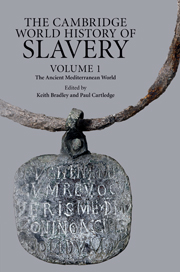Book contents
- Frontmatter
- Contents
- Series editors' introduction
- List of figures
- Acknowledgements
- Introduction
- 1 Slavery in the ancient Near East
- 2 Slaves in Greek literary culture
- 3 Classical Athens
- 4 The Helots: a contemporary review
- 5 Slavery and economy in the Greek world
- 6 The slave supply in classical Greece
- 7 Slavery and the Greek family
- 8 Resistance among chattel slaves in the classical Greek world
- 9 Archaeology and Greek slavery
- 10 Slavery in the Hellenistic world
- 11 Slavery and Roman literary culture
- 12 Slavery in the Roman Republic
- 13 Slavery Under the Principate
- 14 The Roman slave supply
- 15 Slave labour and Roman society
- 16 Slavery and the Roman family
- 17 Resisting slavery at Rome
- 18 Slavery and Roman material culture
- 19 Slavery and Roman law
- 20 Slavery and the Jews
- 21 Slavery and the rise of Christianity
- 22 Slavery in the late Roman world
- Bibliography
- General index
- Index of ancient passages cited
- Index of inscriptions and papyri
- Index of Jewish and Christian Literature Cited
12 - Slavery in the Roman Republic
Published online by Cambridge University Press: 28 September 2011
- Frontmatter
- Contents
- Series editors' introduction
- List of figures
- Acknowledgements
- Introduction
- 1 Slavery in the ancient Near East
- 2 Slaves in Greek literary culture
- 3 Classical Athens
- 4 The Helots: a contemporary review
- 5 Slavery and economy in the Greek world
- 6 The slave supply in classical Greece
- 7 Slavery and the Greek family
- 8 Resistance among chattel slaves in the classical Greek world
- 9 Archaeology and Greek slavery
- 10 Slavery in the Hellenistic world
- 11 Slavery and Roman literary culture
- 12 Slavery in the Roman Republic
- 13 Slavery Under the Principate
- 14 The Roman slave supply
- 15 Slave labour and Roman society
- 16 Slavery and the Roman family
- 17 Resisting slavery at Rome
- 18 Slavery and Roman material culture
- 19 Slavery and Roman law
- 20 Slavery and the Jews
- 21 Slavery and the rise of Christianity
- 22 Slavery in the late Roman world
- Bibliography
- General index
- Index of ancient passages cited
- Index of inscriptions and papyri
- Index of Jewish and Christian Literature Cited
Summary
INTRODUCTION
The Republican period of Rome's history occupied half a millennium, from the late sixth century to the late first century bc. It was characterised by a form of government that distributed public rights and responsibilities among a group of interdependent entities – magistrates, senate, citizens – in a cohesive system intended to prevent the monopolisation of political power by a single individual. At the beginning of the period Rome was a small city-state, comparable to and no more distinctive than many other communities in peninsular, especially central, Italy. By the end of the period it was by far the largest city in the ancient Mediterranean world – larger than any other European city until the modern era – with a population conventionally estimated at close to one million. It controlled a vast empire embracing much of continental Europe, parts of North Africa, and regions in the Near East, and indirectly its influence extended further still. The preservation of political freedom within the civic community was a hallmark of Republican government, but it did not deter or prevent Romans from subjecting others to their will.
There are no contemporary sources to show with any certainty how the Republican form of government was instituted. Later Romans believed that it came into existence as a reaction against tyrannical rule exercised in the sixth century by a sequence of overlords of foreign, especially Etruscan, origin (which modern scholarship denies). At no point, however, was the constitution given written form.
- Type
- Chapter
- Information
- The Cambridge World History of Slavery , pp. 241 - 264Publisher: Cambridge University PressPrint publication year: 2011
- 29
- Cited by



